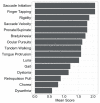The Association between CAG Repeat Length and Age of Onset of Juvenile-Onset Huntington's Disease
- PMID: 32825467
- PMCID: PMC7564343
- DOI: 10.3390/brainsci10090575
The Association between CAG Repeat Length and Age of Onset of Juvenile-Onset Huntington's Disease
Abstract
There is a known negative association between cytosine-adenine-guanine (CAG) repeat length and the age of motor onset (AMO) in adult-onset Huntington's Disease (AOHD). This relationship is less clear in patients with juvenile-onset Huntington's disease (JOHD), however, given the rarity of this patient population. The aim of this study was to investigate this relationship amongst a relatively large group of patients with JOHD using data from the Kids-JOHD study. Additionally, we analyzed data from the Enroll-HD platform and the Predict-HD study to compare the relationship between CAG repeat length and AMO amongst patients with AOHD to that amongst patients with JOHD using linear regression models. In line with previous reports, the variance in AMO that was predicted by CAG repeat length was 59% (p < 0.0001) in the Predict-HD study and 57% from the Enroll-HD platform (p < 0.0001). However, CAG repeat length predicted 84% of the variance in AMO amongst participants from the Kids-JOHD study (p < 0.0001). These results indicate that there may be a stronger relationship between CAG repeat length and AMO in patients with JOHD as compared to patients with AOHD. These results provide additional information that may help to model disease progression of JOHD, which is beneficial for the planning and implementation of future clinical trials.
Keywords: CAG; juvenile-onset Huntington’s disease; motor onset.
Conflict of interest statement
The authors declare no conflict of interest. The funders had no role in the design of the study; in the collection, analyses, or interpretation of data; in the writing of the manuscript; or in the decision to publish the results.
Figures


References
-
- Macdonald M.E., Ambrose C.M., Duyao M.P., Myers R.H., Lin C., Srinidhi L., Barnes G., Taylor S.A., James M., Groot N., et al. A novel gene containing a trinucleotide repeat that is expanded and unstable on Huntington’s disease chromosomes. Cell. 1993;72:971–983. doi: 10.1016/0092-8674(93)90585-E. - DOI - PubMed
-
- Andrew S.E., Goldberg Y.P., Kremer B., Telenius H., Theilmann J., Adam S., Starr E., Squitieri F., Lin B., Kalchman M.A., et al. The relationship between trinucleotide (CAG) repeat length and clinical features of Huntington’s disease. Nat. Genet. 1993;4:398–403. doi: 10.1038/ng0893-398. - DOI - PubMed
Grants and funding
LinkOut - more resources
Full Text Sources

